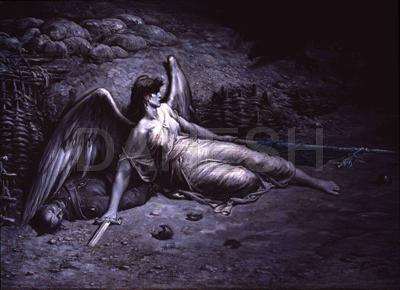Gustave Doré (French, 1832–1883)
The Black Eagle of Prussia, 1871
Oil on canvas, 51 x 76 3/4 in.
2002.60

The upheaval, despair, and crushing defeat France suffered in its war against Prussia (1870–71) was an intensely personal subject for many artists who lived through the experience. As a native of Strasbourg, a city routed by the Germans early in the conflict, Doré held particularly strong feelings of patriotism, and thus joined the National Guard in 1870. Already established as a prolific illustrator and painter, he produced numerous images of the conflict, including The Black Eagle of Prussia, which was grouped together with The Defense of Paris and The Enigma in the artist’s posthumous sale in 1884 under the title Souvenirs of 1870. Here, the vanquished French Republic, personified by a winged woman wearing a robe and Phrygian bonnet and clutching a broken sword, lies on a battlefield among her fallen soldiers, as the menacing black eagle of Prussia bears down upon her. In its depiction of grief and hopelessness, the picture conveys the fears Doré expressed in a letter he wrote in September 1870, just before the siege of Paris began: “Our misfortune is immense, and our anguish terrible. How shall we ever emerge from this gulf of blood and abandonment into which poor France is plunged? No hope and no solution gleams on the horizon…“


